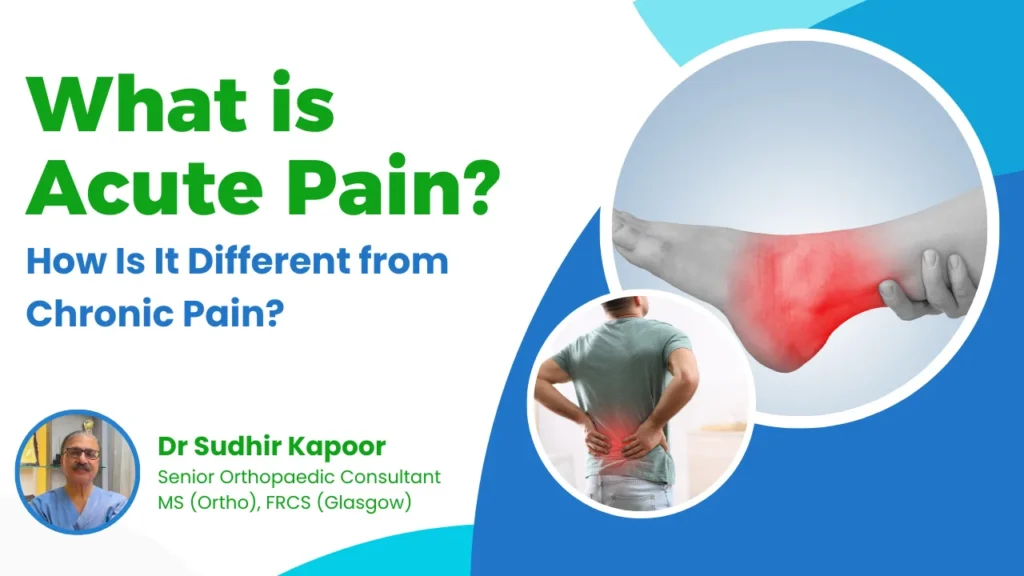Pain is a common experience that everyone encounters at some point in their life. However, not all pain is the same, and understanding the difference between acute pain and chronic pain is vital for proper diagnosis and treatment. In this blog, we’ll explore what acute pain is, how it differs from chronic pain, and how these two types of pain are treated by experts like Dr. Sudhir Kapoor, a leading Orthopedic surgeon in Delhi with over 40 years of experience.
What is Acute Pain?

Acute pain is short-term pain that arises suddenly in response to an injury or illness. It serves as a warning system for the body, alerting us to possible harm or tissue damage. Acute pain typically subsides once the underlying cause is treated or healed, and it rarely lasts beyond few days to few weeks.
Common Causes of Acute Pain:
- Injuries: Fractures, sprains, cuts, and bruises.
- Surgical Procedures: Post-operative pain.
- Illnesses: Infections, kidney stones, or appendicitis.
- Accidents: Falls, sports injuries, or vehicle collisions.
Acute pain can be sharp, throbbing, or aching, depending on the cause. It usually resolves once the underlying condition is managed or healed. For example, if you sprain your ankle, the acute pain will decrease as the ankle heals over time.
What is Chronic Pain?

Unlike acute pain, chronic pain lasts for longer periods, typically beyond six months, and persists even after the initial injury or illness has healed. Chronic pain can range from mild to severe and may not have an apparent cause. It often affects a person’s physical and emotional well-being, leading to difficulty performing everyday tasks and reduced quality of life.
Common Causes of Chronic Pain:
- Arthritis: Conditions like osteoarthritis or rheumatoid arthritis.
- Back Problems: Chronic lower back pain due to disc issues or spinal conditions.
- Nerve Damage: Neuropathy or nerve injuries that continue to cause pain after the initial injury has healed.
- Fibromyalgia: A condition characterized by widespread musculoskeletal pain.
Chronic pain may be constant or intermittent and can affect multiple areas of the body. It requires a more comprehensive treatment approach, often involving medications, physical therapy, and lifestyle changes.
Key Differences Between Acute and Chronic Pain
Understanding the differences between acute and chronic pain helps in determining the best treatment options. Let’s compare them based on various factors:
| Factor | Acute Pain | Chronic Pain |
| Duration | Short-term (less than 6 months) | Long-term (6 months or more) |
| Cause | Direct cause (injury or illness) | May have no clear cause |
| Function | Alerts the body to injury or damage | Often unrelated to current tissue damage |
| Treatment | Resolves with healing or treatment | Requires long-term management |
| Impact | Temporary, limited disruption | Affects quality of life, and can lead to depression and anxiety |
Treatment for Acute Pain
The treatment for acute pain focuses on addressing the immediate cause and promoting healing. The goal is to reduce pain and inflammation and restore function as quickly as possible.
Common Treatment Options for Acute Pain:
- Medications: Over-the-counter pain relievers such as ibuprofen or acetaminophen are often used to manage acute pain. In some cases, stronger prescription medications may be necessary.
- Rest and Ice: Resting the injured area and applying ice can reduce swelling and relieve pain.
- Physical Therapy: For certain injuries, physical therapy may be recommended to strengthen the affected area and promote healing.
- Surgical Intervention: If acute pain is due to a severe injury or medical condition, surgery may be required to repair the damage.
Treatment for Chronic Pain
Chronic pain management requires a more holistic approach, as it often persists despite the healing of the initial injury or condition. Treatments focus on controlling the pain and improving the patient’s quality of life.
Common Treatment Options for Chronic Pain:
- Medications: Prescription medications such as opioids, antidepressants, or anticonvulsants may be used to manage chronic pain. Non-steroidal anti-inflammatory drugs (NSAIDs) can also be effective.
- Physical Therapy: Chronic pain often leads to reduced mobility, and physical therapy can help improve function and reduce discomfort.
- Pain Management Programs: Multidisciplinary pain management programs that include physical therapy, counselling, and lifestyle changes can help patients cope with chronic pain.
- Alternative Therapies: Techniques such as relaxation techniques, and mindfulness meditation can be helpful in managing chronic pain.
Expert Pain Management in Delhi
If you’re struggling with acute or chronic pain, expert care from an experienced orthopaedic surgeon like Dr. Sudhir Kapoor can make all the difference. With over 40 years of experience in treating joint pain, injuries, and chronic conditions, Dr. Kapoor has led Orthopaedic Departments at prestigious institutions such as Lady Hardinge Hospital, ESI Hospital in Basaidarapur, and the Indian Spinal Injury Centre in Delhi. His patient-focused approach ensures personalized care for each individual.
Whether you’re dealing with a short-term injury or a long-term condition like arthritis, Dr. Kapoor can develop a treatment plan that addresses your specific needs, helping you regain mobility and reduce pain.





